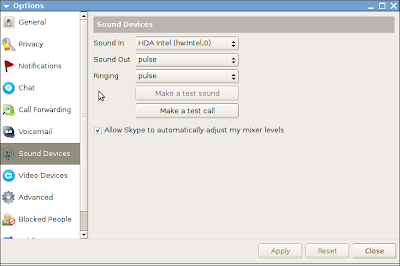Update 2009.05.12: see this newer post:
Linux on a Fujitsu U810, P1620 - Touchscreen IVThis is a replacement of my previous entries on how to get the touchscreen working; please forget about previous posts (
I and
II), which works better and it's easier to install and maintain.
In order to have the touchscreen working, here's the final solution where:
- the point precision is very sharp
- works with standard Xorg drivers
- works after suspending / resume cycle without trouble
- works after rotating the screen
- works even with an external monitor connected, so the touchscreen is remapped to fit the whole screen area
- works very nicely for clicking as well as for ink-painting/writing with ink software like xournal !!!
The solution include these steps:
- configure bios to tablet mode
- install a kernel module: u810_tablet
- copy two files to make the u810_tablet module load correctly at boot and when X loads
- install one python script and one small c program to have the touchscreen work correctly after rotation
1. configure bios to tablet modego into bios and select touchscreen to work in tablet mode
2 install a kernel module: u810_tabletLatest version: 0.2.4 (2009.04.20)
Download the
source code for the u810_tablet kernel module, or just
download the already compiled one (for ubuntu 9.04, kernel 2.6.28).
To compile the module:
- make sure you have the linux development environment installed; I would suggest to install the packages using synaptics package manager, and select linux-headers, gcc
- uncompress the downloaded file, cd to the newly created directory and just type
# make
and as root,
# make install
To just install the already compiled module (if you compiled the module, you don't need to follow this step):
as root, copy the module file (u180_tablet.ko) to
/lib/modules/`uname -r`/extra/
# cp u810_tablet.ko /lib/modules/`uname -r`/extra/as root, run depmod command
# depmod -a
3 copy or edit two files to make the u810_tablet module load correctly at boot and when X loadsIn order to have the module load correctly at boot, as root edit the file /etc/rc.local and insert the following lines at any place (you can
download rc.local here):
# Correct u810_tablet module load - start
# Author: zmiq2
# Info: spareinfo.blogspot.com
MODPATH=/sbin
RMMOD=$MODPATH/rmmod
MODPROBE=$MODPATH/modprobe
. /lib/lsb/init-functions
log_action_begin_msg "Starting u810_tablet module load"
log_progress_msg " u810_tablet module load:unload usbhid"
$RMMOD usbhid
log_progress_msg " u810_tablet module load:load u810_tablet"
$MODPROBE u810_tablet
log_progress_msg " u810_tablet module load:reload usbhid"
$MODPROBE usbhid
log_action_begin_msg "Finished u810_tablet module load"
log_end_msg 0
# Correct u810_tablet module load - end
In order to have the windowing system recognize the module, copy
this file as /etc/hal/fdi/policy/u810_tablet.fdi.
4 install one python script and one small c program to have the touchscreen work correctly after rotationDownload
u810_rotate_helper and
u810_rotate.py.
as root,
- copy both files to /usr/bin
- make u810_rotate_helper suid:
# chmod +s /usr/bin/u810_rotate_helperSource
code for u810_rotate_helper is here. You can easily compile it yourself just running the command
gcc u810_rotate_helper.c -o u810_rotate_helper.
Activate u810_rotate.py to start when you log into gnome
Once logged into gnome, go to System -> Preferences -> Starup Applications and add /usr/bin/u810_rotate.py to start when you log in
Reboot and enjoy the touchscreen !!I can recommend xournal, gournal as hand-writing note taking applications (no handwriting recognition though).
You'll need to repeat step 2 every time there's a new kernel version (like if you change from 2.6.28 to 2.6.29) but not if you just stick to the same ubuntu release (where usually kernel version after upgrade goes from 2.6.28-8 to 2.6.28-11).
Pending tasks- autorotate integrated mouse-pointer coordinates when screen is rotated. That should be easy....
- configure evdev to handle long-press as right-mouse click
If you installed a previous version detailed in a previous post- restore your initramfs:
make sure u180_tablet
is not in /etc/initramfs-tools/modules file; if it was before, remove it and as root run the command
# update-initramfs -u 'all'- restore your acpi-support file
make sure u810_tablet
is not included in in the MODULES variable in /etc/default/acpi-support file
Developer notes- currently if using rotation using xinput facilities with evdev module does not work properly, even there's a bug fix already tested that suggests that it should work, so rotation is made by the driver
- u810_tablet module parameters
orientation=normal:0|right:1|inverted:2|left:3
maxx,maxy,minx,miny (when normal)
printpos=0|1, to print via /var/log/kern.log x/y coordinates, for debugging

